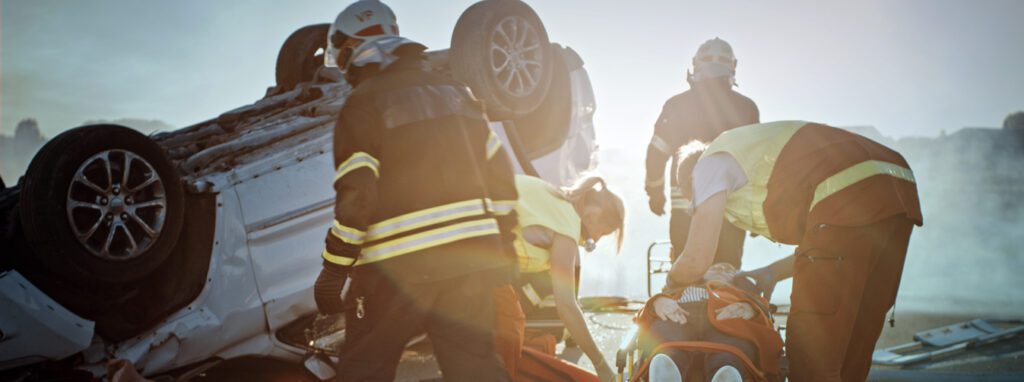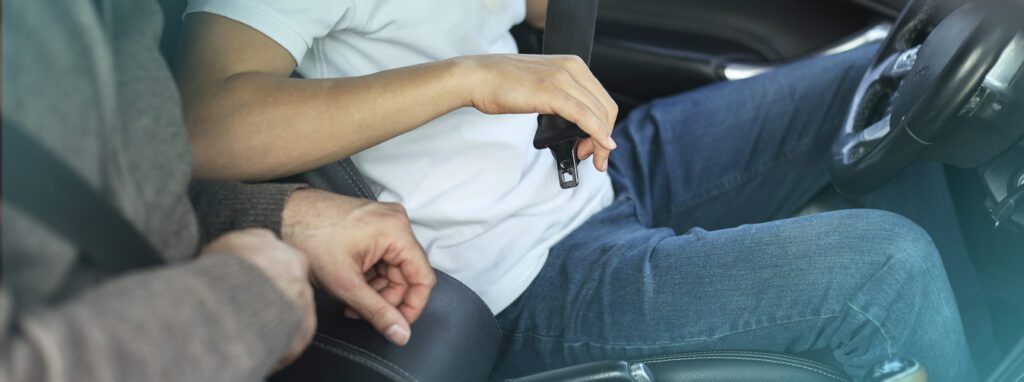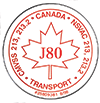Even good drivers make mistakes. Driver-assist safety features can help!
Welcome to a new era of vehicle safety
In-vehicle driver-assist safety features are rapidly becoming ‘must haves’ and many will eventually become standard in new vehicles. Driver-assist technology can detect potential collisions and help to avoid a crash. It can protect your family’s safety and save you the cost and inconvenience of an at-fault collision claim.
Remember – these safety features are no substitute for an alert driver. Learn more about proper use of driver-assist technology. Always pay attention and drive safe!
Forward collision warning with automatic emergency braking
This feature can warn you of a potential collision ahead and may apply the brakes if you don’t react in time.
How it works
Sensors monitor the distance and relative speed between vehicles and supply an audible warning or visual alert to the driver if the system senses a potential collision. If the driver fails to brake or steer to avoid a collision, systems with automatic emergency braking will apply the brakes to mitigate the severity of the crash – or prevent it altogether.
Best thing about it
Studies show it can prevent up to 50 per cent of rear-end crashes, or at the very least may lessen the severity of collisions.
Tip
Works best at city speeds and in clear weather conditions. It is not designed to detect pedestrians. Always leave a safe following distance.
Blind-spot detection
This technology detects nearby vehicles not visible in your mirrors, and alerts you to remain in your lane.
How it works
These systems use sensors to monitor nearby lanes, and can determine when other vehicles approach or enter a vehicle’s blind spot. When this occurs, the system warns the driver with a visual alert, usually in or near the side-view mirror. Should the driver put on their signal to move into that occupied lane, some systems include a sound warning. The alert stops when the adjacent vehicle is no longer in the driver’s blind spot.
Best thing about it
Provides an extra set of eyes for those hard-to-see angles.
Tip
Continue to look behind you and use your mirrors. The one time you don’t check could cost a life. Warnings may not detect fast approaching traffic or motorcyclists.
Lane-departure warning and lane-keeping assist
Lane departure alerts you if you accidentally drift into another lane. Lane keeping automatically helps move you back into your lane.
How it works
These systems track a vehicle’s position in a lane. If the system detects the vehicle has, or will, inadvertently stray out of the lane, it will alert the driver. Most systems consider the movement unintentional if the driver has not used the turn signal. Lane-keeping assist systems help direct the vehicle back into the lane through light steering or braking.
Best thing about it
Addresses some of the most dangerous mistakes, such as drifting into oncoming traffic.
Tip
Effectiveness is affected by snow, ice and worn lane markings. Even with this features, driving requires your total attention.
Adaptive cruise control
This provides a new spin on ‘normal’ cruise control by automatically adjusting your speed in relation to the vehicle ahead, to maintain a safe following distance.
How it works
Like regular cruise control, this feature allows drivers to set a desired travel speed. The benefit of this feature is that sensors maintain a safe following distance to the vehicle ahead. If the lead vehicle is travelling at a lower speed, adaptive cruise control slows your vehicle to maintain a safe preset following distance. Should the lead vehicle speed up, adaptive cruise control will accelerate your vehicle, maintaining the same safe distance until you return to your initial set cruise speed.
Best thing about it
Reduces the risk of collision and even improves fuel consumption.
Tip
Like other cruise control settings, it is ideal for highways, but not for city streets or slippery conditions.
Backup camera and warning
A backup camera gives you an extra set of eyes in the back of your head, and helps you see behind your vehicle. It is standard on all new vehicles as of May, 2018. Newer versions can warn you to apply the brake, and some can sense objects approaching from the side.
How it works
These systems use a display screen to help a driver see what is directly behind their vehicle when backing up. Some systems include lines to help guide the driver.
Best thing about it
Provides greater safety around small children and pets, which can be difficult to see from a rear view mirror.
Tip
The camera may not be clear in certain lighting conditions. Warning sensors only detect a limited distance. Make it a habit to walk around the vehicle before you start, and intermittently check behind as you reverse.
Adaptive headlights
These headlights increase visibility around curves and over hills. They swivel to illuminate the path you are driving rather than aiming straight ahead on a curve or upward on a hill.
How it works
Adaptive headlights help drivers see better on dark curved roads and over hills. The active lights pivot in the direction of travel when a driver steers around curves or corners. The headlights adjust based on steering wheel movement and inclination of the road to illuminate the road ahead.
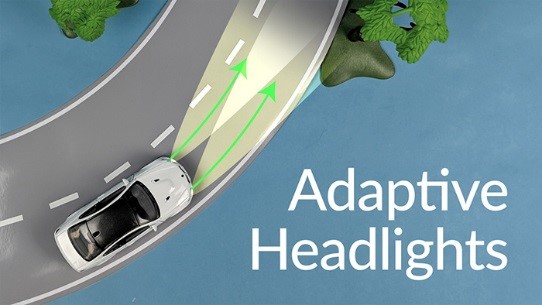
Best thing about it
Improves visibility in dark rural areas and helps you spot hazards such as wildlife.
Tip
Continue to drive to conditions and keep your headlights clean.
Electronic stability control
Electronic stability control helps you avoid losing control and spinning out. The technology counteracts understeering and oversteering by briefly braking the appropriate wheel to stabilize your vehicle.
How it works
Electronic stability control, or ESC, is an extension of anti-lock braking technology with speed sensors and independent braking for each wheel. When steering and rotation sensors detect that the vehicle isn’t pointed in the direction indicated by the steering wheel position, ESC automatically brakes the appropriate wheel to help the driver maintain control. In many cases, engine throttle also is reduced.
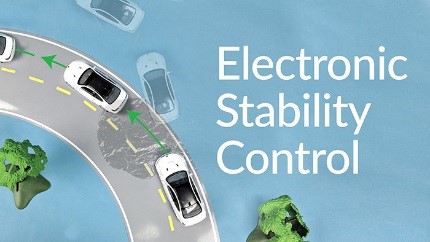
Best thing about it
Lowers the risk of fatal single-vehicle crashes by 56 per cent, and fatal rollovers by 70 to 90 per cent.
Tip
Standard in all new vehicles since 2012, it is considered a ‘must have’ feature for novice drivers and is highly recommended when buying a previously-owned vehicle.
Anti-lock brakes (ABS)
The anti-lock braking system, or ABS, is designed to help you maintain some steering ability and avoid skidding while braking.
How it works
ABS uses wheel speed sensors to determine if one or more wheels are locking up during braking. If a wheel locks up while you’re braking, a series of hydraulic valves limit or reduce the braking on that wheel. This prevents skidding and allows you to maintain steering control.
Best thing about it
It’s automatic! Simply apply steady pressure to the brake. There’s no need to take your foot off the brake and “pump”.
Tip
While ABS can significantly increase the control you have over your vehicle, it is your responsibility to drive at reasonable speeds for weather and traffic conditions.
Learn more about new vehicle technology
See additional video information on specific features. Note that these links take you outside the Manitoba Public Insurance website:
- Forward collision warning with automatic emergency braking
- Blind-spot detection
- Lane-departure warning and lane-keeping assist
- Adaptive cruise control
- Backup camera
- Adaptive headlights
- Electronic stability control
Additional information is available on several independent, authoritative sites. Note that these links take you outside the Manitoba Public Insurance website:
Transport Canada: advanced vehicle technology
Transport Canada sets safety standards for the design, construction and importation of the many types of motor vehicles that share our roads. This site provides detailed information on the many new vehicle safety features available in Canada.
The Insurance Institute for Highway Safety
The U.S. Insurance Institute for Highway Safety (IIHS) is an independent, nonprofit scientific and educational organization dedicated to reducing losses — deaths, injuries and property damage — from motor vehicle crashes. The IIHS site provides easy-to follow information on how crash-avoidance features work, outlines the features available by vehicle make, and lists top safety picks.
MyCarDoesWhat.org is a U.S. campaign to educate drivers on new vehicle safety technologies. The site explains 40 individual safety features, and includes a series of fun and informative videos.
Consumer Reports – Cars with Advanced Safety Systems
Consumerreports.org provides a detailed list of cars with features that help drivers avoid or mitigate collisions.
